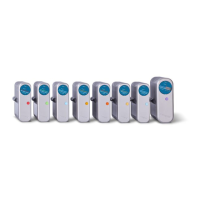ENGINEERING MANUAL OF AUTOMATIC CONTROL
CONTROL FUNDAMENTALS
13
Fig. 12. Granular Bed Sorption Unit.
Sprayed cooling coils (Fig. 13) are often used for space humidity
control to increase the dehumidifier efficiency and to provide year-
round humidity control (winter humidification also).
DRY AIR
HUMID
AIR
ROTATING
GRANULAR
BED
SORPTION
UNIT
SCAVENGER
AIR
HEATING
COIL
HUMID AIR
EXHAUST
C2709
MOISTURE
ELIMINATORS
SPRAY
PUMP
M10511
COOLING
COIL
Fig. 13. Sprayed Coil Dehumidifier.
For more information on dehumidification, refer to the
following sections of this manual:
— Psychrometric Chart Fundamentals.
— Air Handling System Control Applications.
HUMIDIFICATION
Low humidity can cause problems such as respiratory
discomfort and static electricity. Humidifiers can humidify a
space either directly or through an air handling system. For
satisfactory environmental conditions, the relative humidity of
the air should be 30 to 60 percent. In critical areas where
explosive gases are present, 50 percent minimum is
recommended. Humidification is usually required only during
the heating season except in extremely dry climates.
Humidifiers in air handling systems typically inject steam
directly into the air stream (steam injection), spray atomized
water into the air stream (atomizing), or evaporate heated water
from a pan in the duct into the air stream passing through the
duct (pan humidification). Other types of humidifiers are a water
spray and sprayed coil. In spray systems, the water can be heated
for better vaporization or cooled for dehumidification.
For more information on humidification, refer to the following
sections of this manual:
— Psychrometric Chart Fundamentals.
— Air Handling System Control Applications.
VENTILATION
Ventilation introduces outdoor air to replenish the oxygen
supply and rid building spaces of odors and toxic gases.
Ventilation can also be used to pressurize a building to reduce
infiltration. While ventilation is required in nearly all buildings,
the design of a ventilation system must consider the cost of
heating and cooling the ventilation air. Ventilation air must be
kept at the minimum required level except when used for free
cooling (refer to ASHRAE Standard 62, Ventilation for
Acceptable Indoor Air Quality).
To ensure high-quality ventilation air and minimize the
amount required, the outdoor air intakes must be located to
avoid building exhausts, vehicle emissions, and other sources
of pollutants. Indoor exhaust systems should collect odors or
contaminants at their source. The amount of ventilation a
building requires may be reduced with air washers, high
efficiency filters, absorption chemicals (e.g., activated charcoal),
or odor modification systems.
Ventilation requirements vary according to the number of
occupants and the intended use of the space. For a breakdown
of types of spaces, occupancy levels, and required ventilation,
refer to ASHRAE Standard 62.
Figure 14 shows a ventilation system that supplies 100 percent
outdoor air. This type of ventilation system is typically used
where odors or contaminants originate in the conditioned space
(e.g., a laboratory where exhaust hoods and fans remove fumes).
Such applications require make-up air that is conditioned to
provide an acceptable environment.
EXHAUST
TO
OUTDOORS
EXHAUST
FAN
RETURN
AIR
SPACE
MAKE-UP
AIR
SUPPLY
FAN
COIL
FILTER
OUTDOOR
AIR
SUPPLY
C2711
Fig. 14. Ventilation System Using
100 Percent Outdoor Air.
In many applications, energy costs make 100 percent outdoor
air constant volume systems uneconomical. For that reason,
other means of controlling internal contaminants are available,
such as variable volume fume hood controls, space
pressurization controls, and air cleaning systems.
A ventilation system that uses return air (Fig. 15) is more
common than the 100 percent outdoor air system. The return-
air ventilation system recirculates most of the return air from
the system and adds outdoor air for ventilation. The return-air
system may have a separate fan to overcome duct pressure

